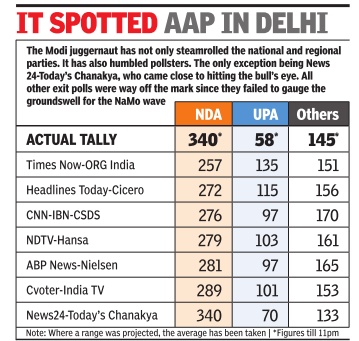Elections in India: opinion polls
This is a collection of articles archived for the excellence of their content. |
Contents |
Opinion polls in India
Why opinion polls are often wide of the mark/ Poor Don’t Always Reveal Their Mind, Middle Class Vocal
Atul Thakur | TIG The Times of India
An analysis of past five general elections shows that opinion polls tend to overestimate BJP, underestimate Cogress and at times go very wrong in assessing regional and smaller parties.
2009
For instance, in 2009, pollsters predicted a near neck-and-neck fi ght between Cogress-led UPA and BJPheaded NDA. It was a general consensus among various poll pundits that although UPA had an edge over NDA, the latter could not be written off. If we take the minimum and the maximum seat forecast of opinion polls, conducted just before the elections, it works out that UPA was supposed to get between 201 and 235 seats while the corresponding numbers for NDA was between 165 and 186 seats. The individual forecast for India’s two largest parties ranged between 146 and 155 for Cogress and from 137 to 147 for BJP.
The actual results surprised everyone—pollsters, media and parties. UPA got 262 seats while NDA was confined to just 157. Party-level predictions also went completely wrong—Cogress went ahead to win 206 seats while BJP could manage to bag just 116 Lok Sabha seats.
2004
For BJP, the 2009 results was perhaps a scaled-down replica of the 2004 debacle. After the good showing in assembly elections in four states, the NDA government decided to go for early polls. Initial opinion polls suggested that NDA was going to sweep the elections. According to poll results of India Today-ORG Marg, published in February 2004, NDA was supposed to get 330-340 seats while Cogress and allies were to be confined to 105-115.
Later the predictions were revised to 260-286 for NDA and 154-180 for Cogress and allies. Then PM Atal Bihari Vajpayee became so confident by what the opinion polls had to say that in an April 17 rally at Nagpur (three days before the elections), he expressed his discomfort with the coalition government and said, “My worry now is, if we are again saddled with a 22-party coalition... such a situation is better avoided.” Perhaps he was indicating that it would be easier to govern the country if his party secured a majority. The results, however, shocked BJP as NDA was reduced to 185 seats, while Cogress and allies won in 217 constituencies.
1999
In the 1999 elections as well, the initial poll predictions suggested that NDA would emerge a clear winner. An opinion poll conducted by DRS for TOI for the August 5-9 period—about a month before the elections—suggested that NDA would get 332 seats while Cogress and allies would manage only 138. India Today-Insight opinion poll also confi rmed TOI’s prediction, giving 322-336 seats to NDA and 132-146 to Cogress and allies. Both opinion polls suggested that BJP and Cogress would increase their individual tally by cutting into the votes of regional parties.
The newspapers were full of stories about a “Vajpayee wave”, which was the focus of BJP’s election campaign. A news report based on TNS MODE survey even suggested that Sushma Swaraj was going to beat Sonia Gandhi in Bellary. The estimates were later revised to 279-336 for NDA and 132-162 for Cogress and allies—much closer to the actual results. Swaraj, however, lost from Bellary and state parties won 162 seats.
1998 and 1996
Opinion polls for 1998 and 1996 elections were, however, closer to the actual results.
Why do opinion polls go wrong in India?
Why do opinion polls tend to favour a particular coalition while underplaying others? First, unlike Western countries, India’s population is not homogeneous—caste, religion and region play an important factor in elections. Also, people, particularly from the weaker section of society, are reluctant to reveal which party they are going to vote. BJP might be getting overplayed because the main support base of the party is the middle class—a section which is not afraid of any post-election harassment and hence they are vocal in sharing their views. On the contrary, key voters of other parties are from vulnerable sections of society and hence they are afraid to share their opinion.
Experts also argue that opinion polls work much better in bipolar elections. In India, where elections are multi-cornered, it is possible that pollsters fail to estimate the strength of regional parties.
2014: Chanakya alone was right
Chanakya is spot on again, others way off the mark
New Delhi:
TEAM TOI
The Times of India May 17 2014
A little known pollster going by the name of Chanakya got it bang on. Polling for News24, Chanakya predicted the NDA would get 340 seats and BJP 291. When counting was still in progress, NDA's tally was 340 seats, and BJP's 282. Chanakya gave Congres 57 seats, while the party's actual tally looks to be 44. Chanakya, led by psephologist V K Bajaj, was clearly an outlier among the exit polls.
While most gave NDA's seat tally at around 280, none gave BJP a clear majority . This is the second time Chanakya has got it right -the earlier time (and its first essay into poll prediction) was during the Delhi assembly election last November when it gave AAP 31 seats, while it won 28.

